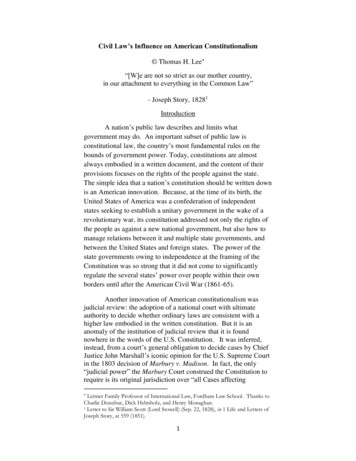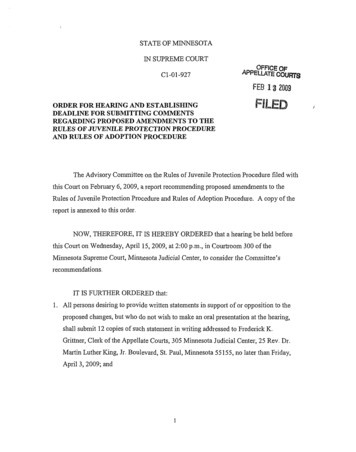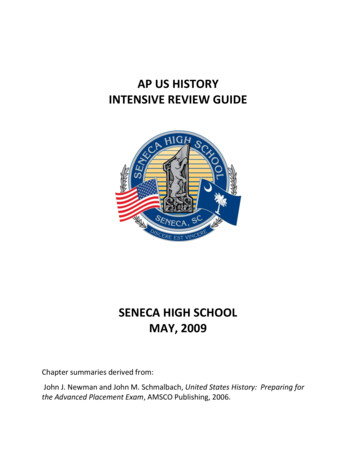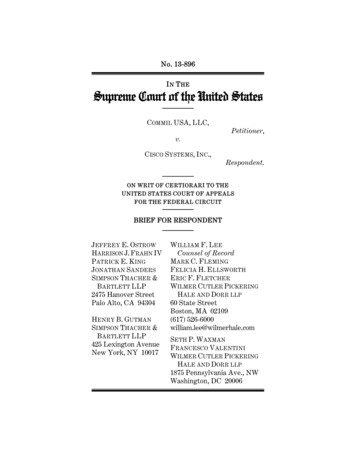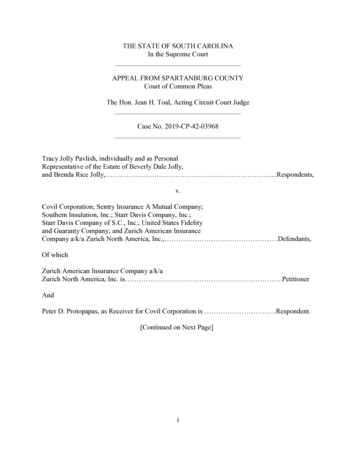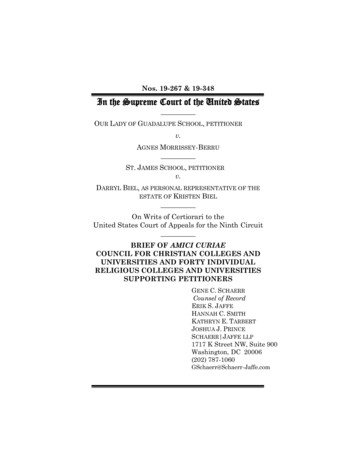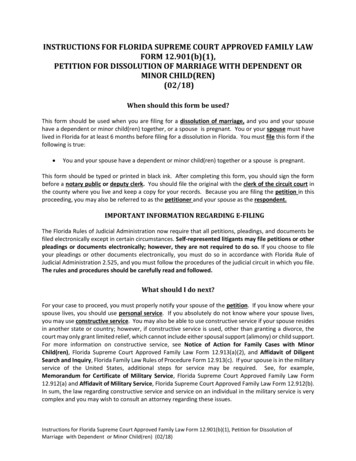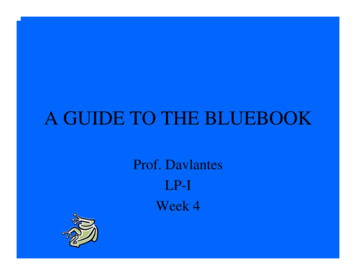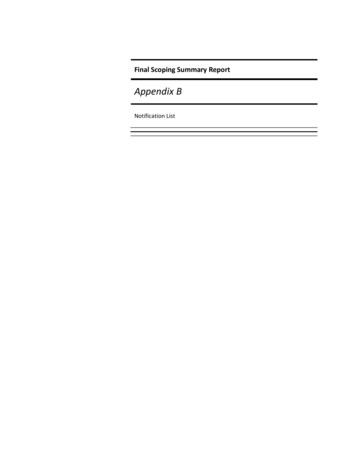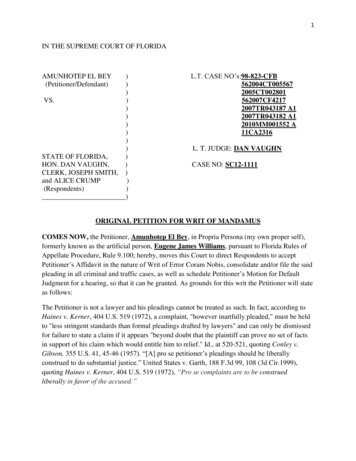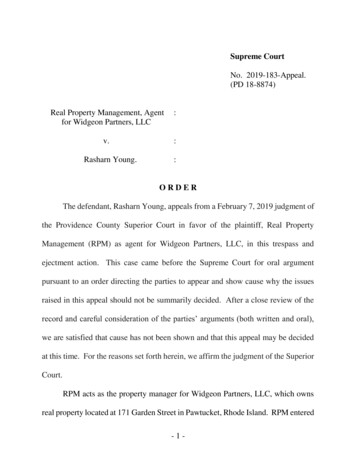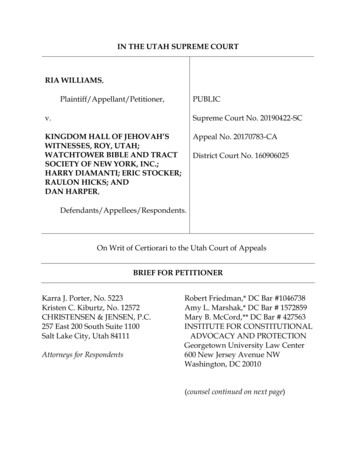
Transcription
IN THE UTAH SUPREME COURTRIA preme Court No. 20190422-SCKINGDOM HALL OF JEHOVAH’SWITNESSES, ROY, UTAH;WATCHTOWER BIBLE AND TRACTSOCIETY OF NEW YORK, INC.;HARRY DIAMANTI; ERIC STOCKER;RAULON HICKS; ANDDAN HARPER,Appeal No. 20170783-CADistrict Court No. 160906025Defendants/Appellees/Respondents.On Writ of Certiorari to the Utah Court of AppealsBRIEF FOR PETITIONERKarra J. Porter, No. 5223Kristen C. Kiburtz, No. 12572CHRISTENSEN & JENSEN, P.C.257 East 200 South Suite 1100Salt Lake City, Utah 84111Attorneys for RespondentsRobert Friedman,* DC Bar #1046738Amy L. Marshak,* DC Bar # 1572859Mary B. McCord,** DC Bar # 427563INSTITUTE FOR CONSTITUTIONALADVOCACY AND PROTECTIONGeorgetown University Law Center600 New Jersey Avenue NWWashington, DC 20010(counsel continued on next page)
Irwin M. Zalkin,* CSB#89957Alexander S. Zalkin,* CSB#280813THE ZALKIN LAW FIRM, P.C.12555 High Bluff Drive, Suite 301San Diego, California 92130Matthew G. Koyle, No. 12577John M. Webster, No. 9065BARTLETT & WEBSTER5093 South 1500 WestRiverdale, Utah 84405*Admitted pro hac vice**Application for admissionpro hac vice forthcomingAttorneys for Petitioner
LIST OF ALL PARTIESThe current parties are Plaintiff/Appellant/Petitioner Ria Williams andDefendants/Appellees/Respondents Kingdom Hall of Jehovah’s Witnesses, Roy,Utah, an unincorporated association; Watchtower Bible and Tract Society of NewYork, Inc.; Harry Diamanti; Eric Stocker; Raulon Hicks; and Dan Harper.The former parties are Defendants Colin Williams and John Does 1-100.i
TABLE OF CONTENTSLIST OF ALL PARTIES . iTABLE OF AUTHORITIES .iiiINTRODUCTION . 1ISSUE PRESENTED . 4STATEMENT OF THE CASE . 4I.Factual Background . 4II. Procedural History. 7SUMMARY OF ARGUMENT. 10ARGUMENT . 15I.Ria Has Stated a Claim for Intentional Infliction of Emotional Distress . 15II. Because Ria’s Claim Depends on Neutral Principles of Law and InvolvesNo Inquiry into Religious Doctrine, the Establishment Clause Poses NoBarrier to Relief . 17A. The Establishment Clause Does Not Preclude Adjudication of LawsuitsWhere There Is No Dispute Over Religious Doctrine . 18B. Ria’s Claim Does Not Violate the Establishment Clause Because ItInvolves No Question of Religious Doctrine . 251. Intentional torts are neutral principles of law. 252. Ria’s IIED claim depends on a neutral principle of law . 31C. The Court of Appeals’ Rule Inappropriately Immunizes ReligiouslyMotivated Conduct . 36III. No “Church Autonomy Doctrine” Immunizes the Elders’ Conduct . 40A. The U.S. Supreme Court Has Rejected a Rule of Automatic“Compulsory Deference” . 41B. A Church’s Right to Decide Religious Disciplinary Matters ExtendsOnly Insofar as Questions of Doctrine Are Presented . 42IV. Granting First Amendment Protection to the Elders’ Conduct WouldSet a Dangerous Precedent . 45CONCLUSION. 49ii
TABLE OF AUTHORITIESCasesAlberts v. Devine,395 Mass. 59 (1985) . 14, 34, 35, 45Banks v. St. Matthew Baptist Church,406 S.C. 156 (2013) . 47Bear v. Reformed Mennonite Church,462 Pa. 330 (1975) . 26, 47Bowie v. Murphy,271 Va. 127 (2006) . 42Brandon ex rel. Estate of Brandon v. Cty. of Richardson,261 Neb. 636 (2001) . 16Bylsma v. R.C. Willey,2017 UT 85, 416 P.3d 595 . 4Candy H. v. Redemption Ranch, Inc.,563 F. Supp. 505 (M.D. Ala. 1983) . 46, 47Cantwell v. Connecticut,310 U.S. 296 (1940) . 36, 37Church of the Lukumi Babalu Aye, Inc. v. City of Hialeah,508 U.S. 520 (1993) . 29Connor v. Archdiocese of Philadelphia,601 Pa. 577 (2009) . 40Costello Pub. Co. v. Rotelle,670 F.2d 1035 (D.C. Cir. 1981) . 38Crouch v. Trinity Christian Ctr. of Santa Ana, Inc.,253 Cal. Rptr. 3d 1 (Ct. App. 2019). 16Dependable Life Ins. Co. v. Harris,510 So. 2d 985 (Fla. Dist. Ct. App. 1987). 17Drejza v. Vaccaro,650 A.2d 1308 (D.C. 1994). 16iii
Duncan v. Peterson,359 Ill. App. 3d 1034 (2005) . 40, 47Employment Div., Dep’t of Human Res. of Oregon v. Smith,494 U.S. 872 (1990) . 37, 38Engel v. Vitale,370 U.S. 421 (1962) . 24, 29F.G. v. MacDonell,696 A.2d 697 (N.J. 1997) . 29Fraley v. State,189 P.3d 580 (Kan. Ct. App. 2008) . 46Franco v. The Church of Jesus Christ of Latter-day Saints,2001 UT 25, 21 P.3d 198 . passimGibson v. Brewer,952 S.W.2d 239 (Mo. 1997). 26, 38Guinn v. Church of Christ of Collinsville,775 P.2d 766 (Okla. 1989) . 35Hancock v. True Living Church of Jesus Christ of Saints of Last Days,2005 UT App 314, 118 P.3d 297 . 30Health Servs. Div., Health & Env’t Dep’t of State of N.M. v. TempleBaptist Church, 814 P.2d 130 (N.M. Ct. App. 1991) . 47Hosanna-Tabor Evangelical Lutheran Church & School v. E.E.O.C.,565 U.S. 171 (2012) . passimJackson v. Brown,904 P.2d 685 (Utah 1995). 15, 31Jeffs v. Stubbs,970 P.2d 1234 (Utah 1998). 38Jones v. Wolf,443 U.S. 595 (1979) . passimKant v. Lexington Theological Seminary,426 S.W.3d 587 (Ky. 2014) . 48Kedroff v. St. Nicholas Cathedral,344 U.S. 94 (1952) . 22, 42, 44iv
Lemon v. Kurtzman,403 U.S. 602 (1971) . 18, 19, 36, 39Mammon v. SCI Funeral Servs. of Fla. Inc.,193 So. 3d 980 (Fla. Dist. Ct. App. 2016). 30Md. & Va. Eldership of Churches of God v. Church of God at Sharpsburg, Inc.,396 U.S. 367 (1970) . 23Mich. Dep’t of Soc. Servs. v. Emmanuel Baptist Preschool,434 Mich. 380 (1990) . 47Molko v. Holy Spirit Ass’n,46 Cal. 3d 1092 (1988) . 26, 30, 35Nally v. Grace Community Church of the Valley,47 Cal. 3d 278 (1988) . 33Ondrisek v. Hoffman,698 F.3d 1020 (8th Cir. 2012) . 14, 26, 46, 47Presbyterian Church in U.S. v. Mary Elizabeth Blue HullMem’l Presbyterian Church, 393 U.S. 440 (1969). 19, 22, 25, 29Prince v. Bear River Mut. Ins. Co.,2002 UT 68, 56 P.3d 524 . 8, 15, 16Prince v. Massachusetts,321 U.S. 158 (1944) . 37Reynolds v. MacFarlane,2014 UT App 57, 322 P.3d 755 . 32Reynolds v. United States,98 U.S. 145 (1878) . 2, 37, 39Roppolo v. Moore,644 So. 2d 206 (La. Ct. App. 1994) . 30Schuurman v. Shingleton,2001 UT 52, 26 P.3d 227 . 17Serbian E. Orthodox Diocese for U. S. of Am. & Canada v. Milivojevich,426 U.S. 696 (1976) . passimState v. Davis,972 P.2d 388 (Utah 1998). 4v
Stien v. Marriott Ownership Resorts, Inc.,944 P.2d 374 (Utah Ct. App. 1997) . 32Tomic v. Catholic Diocese of Peoria,442 F.3d 1036 (7th Cir. 2006) . 47United States v. Ballard,322 U.S. 78 (1944) . 21Utah Local Gov’t Tr. v. Wheeler Mach. Co.,2008 UT 84, 199 P.3d 949 . 28Walz v. Tax Comm’n,397 U.S. 664 (1970) . 43Watson v. Jones,80 U.S. 679 (1871) . passimWilliams v. Kingdom Hall of Jehovah’s Witnesses,2019 UT App 40, 440 P.3d 820 . passimYoung v. Stensrude,664 S.W.2d 263 (Mo. Ct. App. 1984) . 17StatutesUtah Code § 78B-6-1101 . 32Other AuthoritiesRestatement (Second) of Torts § 46 . 4, 17, 31Restatement (Second) of Torts § 282 . 28vi
INTRODUCTIONWhen Petitioner Ria Williams was 15 years old, four adult male Elders inher Jehovah’s Witnesses congregation—each a Respondent here—played an audiorecording of Ria being raped in an effort to extract from her a confession that shehad sex outside of marriage. Upon hearing the recording, Ria cried, physicallytrembled, and pleaded with the Elders to stop forcing her to relive the scarringexperience. They did not stop. Instead, they continued to play the recording, onand off, for hours. Predictably, Ria suffered humiliation, anxiety, nightmares, lossof appetite, and poor performance in school. To recover for these injuries, Riabrought this suit for intentional infliction of emotional distress.The district court recognized that the Elders’ conduct was “reprehensible”and stated that it would have “no hesitation in sending th[e] claim to the jury” ifit had “occurred in a secular setting.” Nonetheless, the court concluded that theEstablishment Clause of the First Amendment required dismissal because Ria’sinjury occurred in the context of a religious disciplinary proceeding. The court ofappeals went even further, holding that the Establishment Clause broadlyprohibits courts from assessing whether any “religious activity” violates secularstandards.The decisions below rest on a fundamental misunderstanding of theEstablishment Clause. The Clause’s prohibition on government action “respecting
an establishment of religion” does not immunize intentionally tortious conduct—like the seriously harmful acts at issue here—simply because the tortfeasor has areligious motive or the conduct somehow relates to religious discipline. That rule,if allowed to stand, would give actors free rein to injure others under the guise ofreligious freedom—a proposition that the U.S. Supreme Court has rejectedrepeatedly for over a century, going back to its seminal decision that a religiousmotivation is not a valid defense to a bigamy prosecution. See Reynolds v. UnitedStates, 98 U.S. 145, 166–67 (1878) (observing that a contrary rule would also allowfor “human sacrifices” and leave government to “exist only in name”).The dangers of immunity for religiously motivated acts are wide-ranging,even if confined to religious discipline. The constitutional right that the Eldersclaim to psychologically torture Ria to extract a confession would extend equallyto other harmful means of obtaining evidence in the name of religious discipline—whether breaking into a congregant’s home, forcing a congregant to endure sleepdeprivation, or inflicting physical violence. Religious authorities would also beimmune from liability for any injuries caused by the penalty they decide to handdown for a violation of religious law. They could imprison the offendingcongregant, distribute sexually compromising pictures or recordings, oradminister a range of other psychological or corporal punishments. As this caseillustrates, even minor children could not invoke the protections of Utah law once2
the tortfeasor clears the minimal threshold of claiming a religious disciplinarymotive.Instead of paving the way for these harmful results, in the context oflitigation involving a religious party, the Establishment Clause does exactly whatits text suggests: it precludes courts from “establishing” religion by deciding adispute over religious doctrine to declare that one side holds the “correct”understanding of the tenets of faith, thereby “interven[ing] on behalf of [a] group[]espousing particular doctrinal beliefs.” Serbian E. Orthodox Diocese for U. S. of Am.& Canada v. Milivojevich, 426 U.S. 696, 709 (1976). It is thus only when a plaintiff’sclaim depends on first convincing a court of the meaning or truth of religiousdoctrine that deciding the cause of action transgresses the Establishment Clause.By contrast, when a defendant violates an independent and religiously neutralprinciple of civil law, the Establishment Clause imposes no obstacle to relief evenif that defendant asserts that he was motivated by a religious belief.Ria’s claim satisfies these principles. She does not challenge whether theElders had a religious motivation for playing the recording or whether theyproperly followed the dictates of Jehovah’s Witness disciplinary doctrine. Rather,Ria alleges only that, by subjecting a 15-year-old to a recording of her rape, in theface of her serious distress, the Elders violated the secular prohibition on conduct“utterly intolerable in a civilized community” embodied in the tort of intentional3
infliction of emotional distress, see Restatement (Second) of Torts § 46 cmt. d, andtherefore infringed on her rights under Utah law. The Establishment Clause doesnot prevent Utah courts from providing Ria with a remedy under thesecircumstances.ISSUE PRESENTEDThe issue presented is whether the Court of Appeals erred in affirming thedismissal of Petitioner’s complaint on the ground that it was precluded by theEstablishment Clause of the First Amendment to the United States Constitution.This is a question of law that this Court reviews for correctness. E.g., Statev. Davis, 972 P.2d 388, 390 (Utah 1998). “Because this is an appeal from a grant ofa motion to dismiss, [this Court] construe[s] the facts in the light most favorable tothe . . . non-moving part[y].” Bylsma v. R.C. Willey, 2017 UT 85, ¶ 4 n.2, 416 P.3d595, 600 n.2. Petitioner preserved the issue for review. (R. 134–37.)STATEMENT OF THE CASEI.Factual BackgroundPetitioner Ria Williams was born into a family of Jehovah’s Witnesses. (R.79.) Throughout her childhood, Ria belonged to various Jehovah’s Witnessescongregations. (Id.) At the time of the events that are the subject of this litigation,Ria and her family were part of the congregation of Respondent Kingdom Hall of4
Jehovah’s Witnesses of Roy, Utah (“Roy Kingdom Hall”), a local unit of theJehovah’s Witnesses analogous to a local church. (R. 72, 76, 79.)In the summer of 2007, when Ria was 14 years old, she began spending timewith Colin Williams, an 18-year-old fellow Jehovah’s Witness. (R. 72, 79, 259 n.12.)Ria and Mr. Williams shared a mutual friend, and Mr. Williams also knew Ria’ssister. (R. 79, 81.) At that time, Ria made plans to go to the movies with Mr.Williams and their mutual friend. (R. 79.) The trip, however, quickly turned intosomething far different. Their friend could not attend, leaving Ria alone with Mr.Williams. (Id.) After the movie, Mr. Williams took Ria’s cell phone and refused todrive her home or return her phone unless she kissed his cheek, which shedeclined to do. (Id.) In the ensuing months, Mr. Williams’s bullying continued,consistently growing more aggressive and violent. (R. 80–81.)Mr. Williams’s conduct soon escalated into sexual violence against Ria. InDecember 2007, Mr. Williams compelled Ria to get in his car and drove her to a“secluded area,” where he proceeded to “kiss her, and touch her breasts andbetween her legs over the clothes, despite [Ria’s] protests.” (R. 82.) Within twoweeks of that first sexual assault, Mr. Williams raped Ria three times. (R. 82-83.)After Mr. Williams’s sexual assaults on Ria were reported to the Elders,Respondent Roy Kingdom Hall initiated an investigation into whether Ria hadcommitted the sin of “porneia.” (R. 83.) Jehovah’s Witnesses define porneia as5
“unclean sexual conduct that is contrary to ‘normal’ behavior”; the term includessex between two people who are not married. (R. 78.) The Elders—RespondentsHarry Diamanti, Eric Stocker, Raulon Hicks, and Dan Harper—formed a “judicialcommittee” to lead the investigation. (R. 83.) A finding by the committee that Riahad engaged in porneia would carry the potential disciplinary consequence of“disfellowship,” i.e., expulsion from the religious community. (R. 77.)In April 2008, the Elders summoned Ria for questioning in connection withtheir investigation.(R. 83–84.)The Elders first questioned Ria (who wasaccompanied by her mother and stepfather) for 45 minutes about her interactionswith Mr. Williams, including whether Ria had voluntarily engaged in sexualactivity with him. (R. 84.) Having failed to obtain the information they wanted,the Elders then played an audio recording that Mr. Williams had provided thatcaptured the sound of one of the times he had raped Ria. (Id.) Ria had a visceraland visible reaction to the recording. (Id.) She began “crying” and pleading thatthe Elders “not force her to relive the experience of being raped.” (Id.)Ria’s evident distress and clear protest failed to deter the Elders fromcontinuing to play the recording. (Id.) The Elders repeatedly played the recording(stopping intermittently to question Ria) in an effort to get Ria to confess that shehad consented to the sexual activity. (Id.) This pattern continued for at least fourhours, all while, in plain view of the Elders, Ria continued crying and was6
“physically quivering” from the trauma of having to listen to her assault over andover. (Id.) As a result of the Elders’ conduct, Ria—who was then only 15 yearsold—suffered serious harm, including humiliation, embarrassment, anxiety,nightmares, loss of appetite, and poor performance in school. (R. 86, 207–08.) Riasought psychological counseling and medical treatment, and she continues toexperience distress from the Elders’ actions. (R. 84, 86.)In June 2009, the Utah Division of Child and Family Services filed acomplaint against the Elders with the Department of Human Services (“DHS”).(R. 85.) DHS convened an administrative hearing and found that the Elders hadengaged in “Emotional Maltreatment”—defined as “subject[ing] a child topsychologically destructive behavior”—during the meeting at which they playedthe audio recording. (R. 85, 214.)II.Procedural HistoryRia filed this suit in the Second Judicial District Court for Weber County in2016. She named as defendants Respondent Roy Kingdom Hall, RespondentElders, and Respondent Watchtower Bible and Tract Society of New York, Inc., theorganization responsible for national governance of Jehovah’s Witnesses(collectively, “Defendants”).1(R. 72–73.)Ria’s amended complaint (theRia also named as defendants Mr. Williams, who defaulted, and John Does 1–100. These defendants were not involved in the proceedings in the court ofappeals.17
“Complaint”) asserts a claim of intentional infliction of emotional distress (“IIED”)against all Defendants for the Elders’ conduct in repeatedly playing the recording,despite the obvious distress it was causing her.2 (R. 85-86.) Liability for IIED existsunder Utah law when the defendant engages in “outrageous and intolerable”conduct intending that it will cause severe emotional distress. See Prince v. BearRiver Mut. Ins. Co., 2002 UT 68, ¶ 37, 56 P.3d 524, 535; infra at 15. Defendants movedto dismiss Ria’s Complaint, arguing that she failed to state a claim and that, evenif she did, the religion clauses of the United States and Utah Constitutions barredher claims. (R. 97.)The district court granted Defendants’ motion to dismiss under theEstablishment Clause of the First Amendment to the U.S. Constitution. (R. 262.)The court declared that “forcing a minor to listen to an audio recording of heralleged rape is nothing less than reprehensible” and stated that it would have “nohesitation in sending this claim to the jury” if it “had occurred in a secular setting.”(R. 261.) Nonetheless, and “[d]espite th[e] Court’s revulsion at the allegations,”the court held that the religious “setting and context” compelled the court todismiss the Complaint.(R. 261–62.)According to the district court, theIn addition, Ria brought a claim for negligent infliction of emotional distress,which was dismissed below. As noted in the petition for a writ of certiorari, Riadoes not seek review of the dismissal of that claim.28
Establishment Clause precludes any claim that “implicate[s]” how a religiousorganization conducts its disciplinary hearings. Id.The court of appeals affirmed. The court acknowledged that the tort ofintentional infliction of emotional distress is a “generally applicable law.” Williamsv. Kingdom Hall of Jehovah’s Witnesses, 2019 UT App 40, ¶ 17, 440 P.3d 820, 824. Butthe court of appeals found this fact irrelevant under a broad reading of this Court’sstatement in Franco v. The Church of Jesus Christ of Latter-day Saints, 2001 UT 25,¶ 15, 21 P.3d 198, 203, that “tort claims against clerics that require the courts toreview and interpret church law, policies, or practices in the determination of theclaims are barred by the First Amendment.” According to the court of appeals,under Franco, it does not matter “whether the tort law itself is neutral andgenerally applicable” if “the tort law being applied is used to evaluate religiousactivity.” Williams, 2019 UT App 40, ¶ 16, 440 P.3d at 824. Applying this perceivedbar, the court concluded that merely “assess[ing] the ‘outrageousness’ of religiousactivity” violates the Establishment Clause. Id. Thus, because Ria’s claim “aroseout of the manner in which [the Elders] conducted a religiously prescribed judicialcommittee,” the court of appeals concluded that dismissal was proper. 2019 UTApp 40, ¶ 17, 440 P.3d at 825.9
SUMMARY OF ARGUMENTI. Ria’s Complaint alleges a quintessential claim of intentional infliction ofemotional distress. The Elders, four adult men, repeatedly played an audiorecording of Ria, then a 15-year-old girl, being raped at the age of 14,notwithstanding that Ria was crying, physically shaking from distress, andpleading with them to stop. This is exactly the type of outrageous conduct forwhich the tort is designed to provide a remedy, as numerous other courts haverecognized under similar circumstances. It is fitting, therefore, that the districtcourt had “no hesitation” concluding that Ria had stated a claim as a matter of tortlaw.II. Because Ria has stated a claim for intentional infliction of emotionaldistress, the only question at this stage of the proceedings is whether theEstablishment Clause exempts Defendants from this generally applicable tort law.Where, as here, a tort claim merely seeks relief for conduct that infringes on anindividual’s rights under civil law and does not ask a court to resolve any disputedreligious doctrinal matter, the answer is no.A. The Establishment Clause does not bar claims that depend on generallyapplicable principles of tort law. As this Court has recognized, a claim violates theEstablishment Clause under what is known as the “entanglement doctrine” whenresolving the claim requires a court “to review and interpret church law, policies,10
or practices.” Franco, 2001 UT 25, ¶ 12, 21 P.3d at 203. This rule derives from, andis given additional content by, a series of cases in which the U.S. Supreme Courtheld that courts cannot resolve legal claims when doing so would require a courtto decide a dispute about the “correct” interpretation of religious doctrine ordetermine the “truth” of a religious belief. Resolving those disputes would resultin a court placing the weight of government authority behind one group’s view ofreligion or crafting its own religious doctrine—precisely the type of sponsorshipof religious sects and active involvement in religious affairs that the EstablishmentClause forbids. But where a claim depends only on “neutral principles of law”that are “completely secular in operation,” those dangers are absent and theEstablishment Clause poses no barrier to relief. See Jones v. Wolf, 443 U.S. 595, 602–03 (1979).B. Ria’s claim depends on a neutral principle of law and does not violatethe Establishment Clause.As a general matter, intentional torts are neutralprinciples of law. The standard applicable to a given intentional tort existsindependent of the religious identity or motive of a defendant, and it applies toeveryone in society, not just to religious actors or religious functions. Intentionaltorts therefore are unlike the negligence-based clergy malpractice claims that thisCourt held unconstitutional in Franco on the ground that such malpractice claimsrequire a court to devise a religion-specific standard of care.11
What is true of intentional torts generally is true of Ria’s claim specifically.The outrageousness standard that applies to intentional infliction of emotionaldistress claims is the same society-wide standard regardless of religious context ormotive, and it governs all actors, not just clergy. Indeed, the court of appealsacknowledged that the tort of intentional infliction of emotional distress is a“generally applicable law.” Williams, 2019 UT App 40, ¶ 17, 440 P.3d at 825.Moreover, there is nothing specific to Ria’s allegations that alters thisanalysis.She does not question, for example, whether the Elders correctlyfollowed Jehovah’s Witness doctrine when they played the audio recording. Thesole question that Ria’s claim raises is whether the
Mar 21, 2019 · her Jehovah’s Witnesses congregation—each a Responde nt here—played an audio recording of Ria being raped in an effort to extract from her a confession that she had sex outside of marriage. Upon hearing the recording, Ria cried, physically trembled, and pleaded with the Elde

